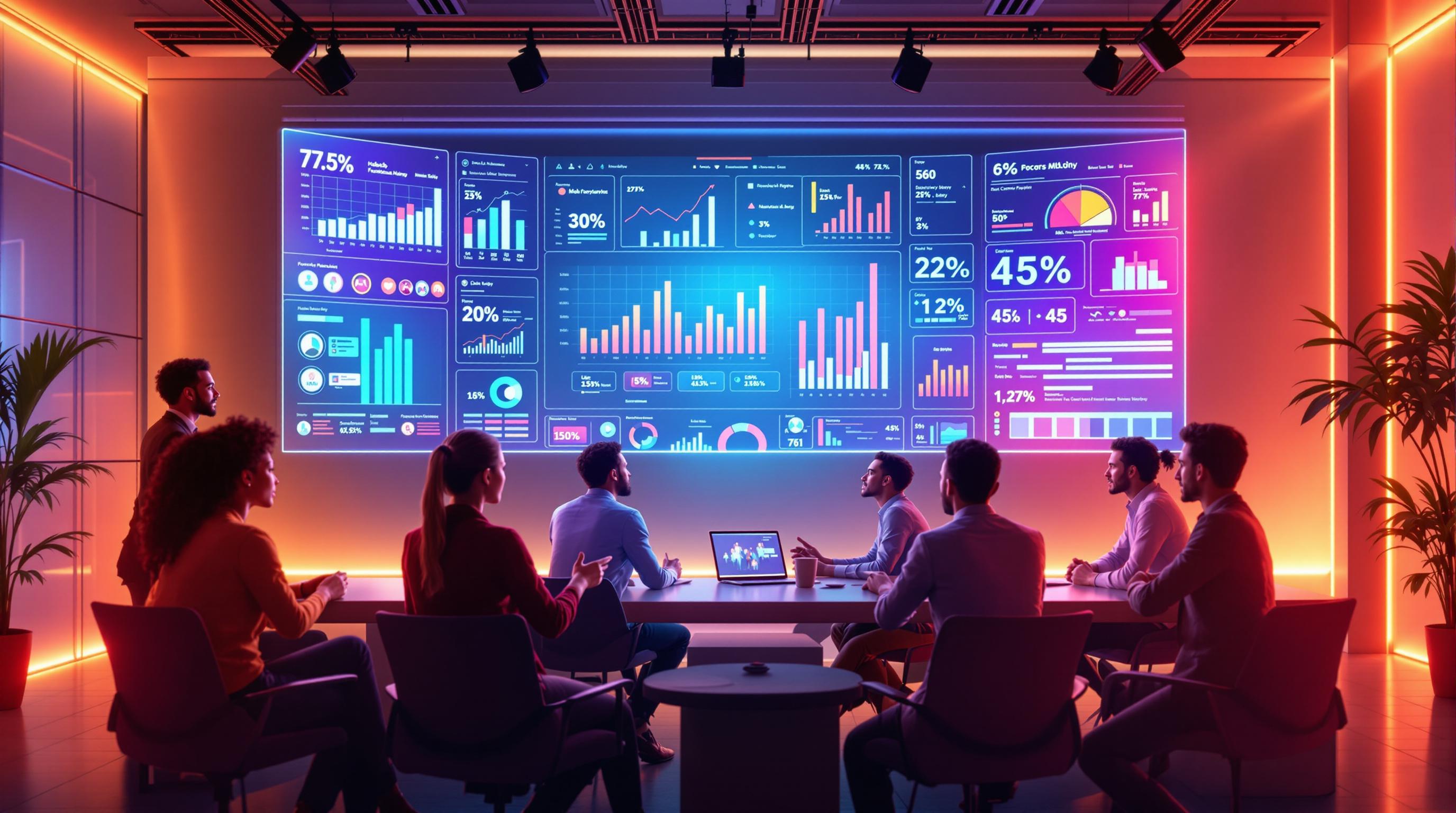Multi-agent AI streamlines workflows by using multiple AI agents that collaborate to manage tasks more efficiently. Here's how it helps:
- Efficiency: Handles multiple tasks simultaneously, speeding up processes.
- Accuracy: Agents validate each other’s work, reducing errors.
- Real-Time Insights: Provides live data for faster decisions.
- Scalability: Adapts to growing business needs with ease.
Key Use Cases:
- Customer Support: Automates responses, personalizes solutions, and escalates complex issues.
- Supply Chain: Optimizes inventory, forecasts demand, and reduces costs.
- Content Creation: Handles research, drafting, and SEO optimization.
Getting Started:
- Choose tools that fit your needs (e.g., TypingMind for no-code setup, MindPal for advanced workflows).
- Define clear roles for each AI agent.
- Test and refine workflows for smooth integration.
Ways Multi-Agent AI Improves Workflow Processes
Specialized Roles and Teamwork
Multi-agent AI systems break down complex workflows into specific tasks, with each agent focusing on what it does best. For instance, in content creation, one agent might handle SEO optimization while another crafts the actual content. By working in tandem and sharing information through shared databases and decision-making modules, these agents ensure tasks are completed efficiently [1] [2].
This setup also improves decision-making. By pooling their expertise, agents can analyze and process data in a more effective way.
Quick and Data-Driven Decisions
Multi-agent systems revolutionize decision-making by analyzing real-time data from various sources simultaneously. This capability allows for faster and more precise outcomes [2].
A great example of this is in supply chain management:
| Decision Area | AI Agent Role | Business Impact |
|---|---|---|
| Inventory Management | Tracks stock levels | Prevents shortages and overstocking |
| Demand Forecasting | Predicts future needs | Improves purchasing strategies |
| Distribution Planning | Optimizes logistics | Cuts shipping costs |
| Supply Chain Risk | Monitors potential risks | Tackles problems before they escalate |
Handling Growth and Changing Needs
Multi-agent systems are built to handle increasing workloads and shifting business demands [2]. Their modular design makes it easy to scale operations - new agents can be added or existing ones reconfigured without disrupting workflows.
This adaptability is especially useful in customer support, where AI agents can be reassigned in real time to handle a surge in inquiries. The system automatically adjusts resources based on current demand, ensuring service quality remains consistent during busy periods [2] [3].
Key features that enable this scalability include:
- Dynamic resource allocation: Tasks are assigned based on priority and agent expertise.
- Automated load balancing: Work is evenly distributed across agents.
- Real-time performance monitoring: The system continuously tracks efficiency and adjusts as needed.
These features ensure workflows stay efficient as businesses expand, making it easier to scale operations without sacrificing performance [2] [5]. Multi-agent AI not only improves current processes but also prepares organizations for future growth and evolving challenges.
Master Multi-AI Agent Workflows in N8N

Steps to Add Multi-Agent AI to Your Workflow
Now that you understand how multi-agent AI can benefit your business, it's time to explore how to integrate these systems into your daily operations.
Selecting the Right Tools and Platforms
The first step is picking tools that fit your specific needs. Not every platform is created equal, so here are some factors to consider when making your choice:
| Selection Criteria | What to Look For | Impact on Workflow |
|---|---|---|
| Scalability | Ability to add new agents easily | Keeps workflows running smoothly as you grow |
| Integration | APIs and compatibility with existing systems | Ensures seamless connection with your current setup |
| User Interface | Low-code or no-code options | Speeds up implementation, even for non-technical users |
| Cost Structure | Pay-per-use or subscription plans | Aligns with your financial goals |
For example, TypingMind offers a drag-and-drop interface that simplifies setup for non-technical teams, while MindPal provides customization options for more complex, large-scale operations. These platforms make it easy to start small and expand as your needs evolve [1].
Defining Roles for Each AI Agent
To get the most out of your AI system, assign clear and distinct roles to each agent. This avoids overlap and ensures your workflow stays efficient. Common roles include:
- Data Analysis: Handling information processing and identifying patterns.
- Communication: Managing internal and external messaging.
- Task Coordination: Overseeing the progress of workflows.
By keeping roles well-defined, agents can work together effectively, sharing information and collaborating without confusion [2][3].
Building and Testing Automated Workflows
Once you've set up roles, it's time to incorporate them into your workflow. Start by mapping out your current processes and pinpointing where AI can make the biggest impact. Then, systematically test the setup to ensure everything runs smoothly.
| Testing Phase | Purpose | Success Metrics |
|---|---|---|
| Setup and Integration | Verify basic functionality and coordination | Agents complete assigned tasks without errors |
| Load Testing | Assess performance under heavy usage | Consistent response times |
| User Acceptance | Test in real-world scenarios | High task accuracy and efficiency |
Leverage analytics tools to track performance and make improvements based on the data. By refining your workflows, you can maximize the benefits of multi-agent AI and create systems that are efficient and ready to handle future demands [3].
sbb-itb-f88cb20
Real-World Uses of Multi-Agent AI
Multi-agent AI is making waves in various industries by tackling complex tasks efficiently. From customer support to supply chain management and content production, its impact is undeniable.
Automating Customer Support
Multi-agent AI systems ensure 24/7 customer service by managing queries, tailoring solutions, and escalating more challenging issues to human agents. This setup leads to faster, more accurate resolutions, boosting customer satisfaction and showing how versatile these systems can be across different sectors [1].
| AI Agent Role | Function | Impact |
|---|---|---|
| First Response | Addresses initial customer queries | Immediate response times |
| Analysis | Examines customer history and context | Personalized solutions |
| Escalation | Passes complex issues to human agents | Smooth problem-solving |
Managing Supply Chains and Inventory
In supply chain management, multi-agent AI excels at predicting demand, optimizing inventory, and managing logistics in real time [2]. Each AI agent focuses on a specific task, enabling businesses to adapt quickly to market changes, reduce storage costs, and maintain product availability.
By analyzing multiple data streams simultaneously, these systems help companies balance inventory levels while cutting operational expenses [3]. While its logistical capabilities are impressive, multi-agent AI also brings efficiency to creative processes like content production.
Creating and Optimizing Content
Multi-agent AI simplifies content production by handling everything from research and drafting to fine-tuning. These systems deliver polished content tailored to audience preferences, enhancing its reach and effectiveness [1].
| Phase | AI Agent Role | Output |
|---|---|---|
| Research | Identifies topics and keywords | Content briefs |
| Creation | Generates initial drafts | Draft content |
| Optimization | Improves SEO and readability | Finalized content |
These examples illustrate how multi-agent AI is transforming industries by improving workflows and boosting efficiency. Its collaborative design ensures high-quality results while adapting to the ever-changing needs of businesses [2] [3].
Tools and Resources for Multi-Agent AI
Having the right tools can make all the difference when setting up multi-agent AI workflows. Below, we highlight some key platforms that can help streamline automation processes.
Best AI Agents: A Tool Directory

Best AI Agents is a go-to directory for finding AI tools tailored to specific workflow needs. It organizes tools into categories based on their primary functions:
| Category | Use Case |
|---|---|
| Writing & Content | Automating content creation |
| Business | Customer service and analytics |
| Development | Software automation pipelines |
| Education | Managing learning processes |
This directory is a great starting point for identifying tools that fit your requirements. Once you’ve narrowed down your options, platforms designed for multi-agent workflows can help you implement them effectively.
MindPal: Managing Multi-Agent Workflows

MindPal is a platform designed to handle workflows involving multiple AI agents. Its standout features include:
- Agent Coordination: Smooth integration and management of multiple AI agents.
- Workflow Tools: Advanced features for automating complex processes.
- Scalability Options: Designed to grow with your automation needs.
MindPal is especially useful for businesses looking to manage large-scale automation with precision and flexibility.
TypingMind: No-Code Workflow Builder

TypingMind simplifies multi-agent AI for teams without technical expertise. It offers:
- A visual workflow designer for quick setup.
- Pre-built templates for common automation tasks.
- Integration options to connect with existing tools.
This platform is perfect for teams that need an easy, no-code solution to implement AI workflows.
Conclusion: Multi-Agent AI and the Future of Workflows
Multi-agent AI is reshaping how businesses handle workflow automation, offering smarter ways to streamline operations.
Key Points for Businesses
These systems allow businesses to tackle complex processes with improved efficiency. By analyzing data, coordinating tasks, and adjusting to changing demands, multi-agent AI has become a powerful tool for managing workflows. They also provide real-time insights, making them an integral part of modern business strategies [3][4].
However, getting the most out of these systems requires careful planning and thoughtful execution.
How to Get Started
If you're ready to bring multi-agent AI into your workflows, here’s how you can begin:
- Audit your current workflows: Understand where automation can make the biggest impact and explore tools through directories like Best AI Agents.
- Start small: Begin with controlled tests of AI solutions before rolling them out across your organization.
- Use specialized platforms: Tools like MindPal can help with workflow management, while TypingMind offers no-code options for easier implementation.
Starting with smaller, focused projects can help your team build confidence and experience. Over time, these pilot projects can evolve into comprehensive systems that adapt to your business needs [1][3].


